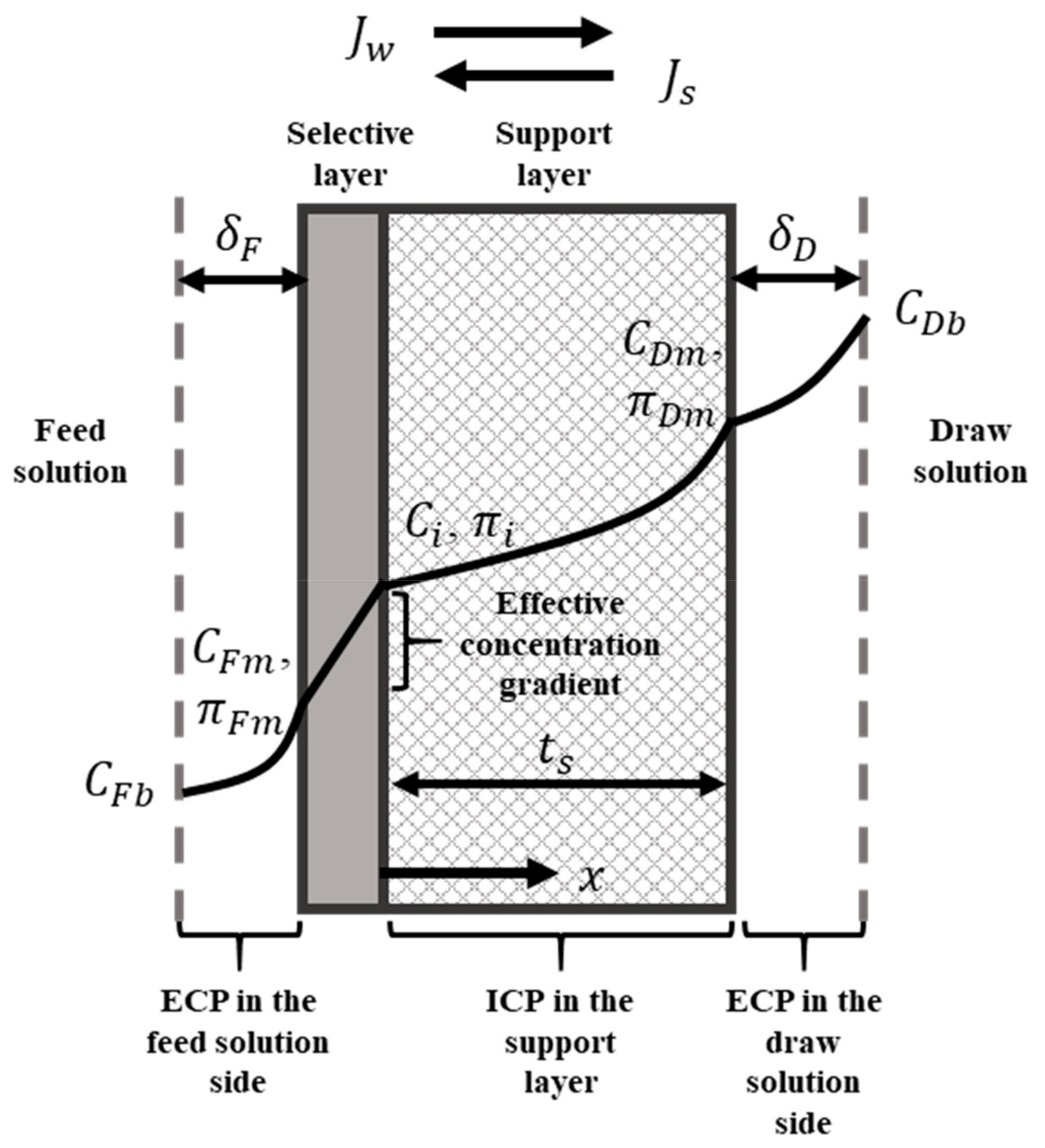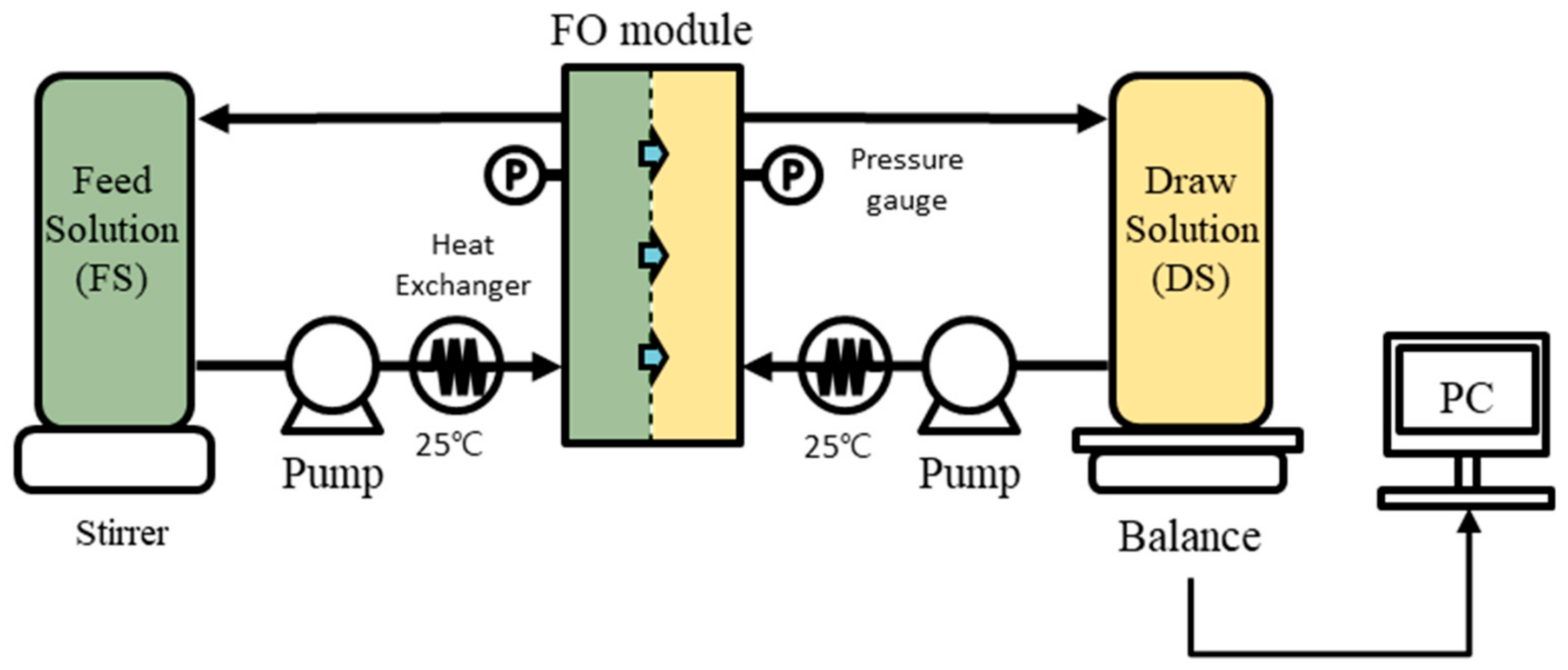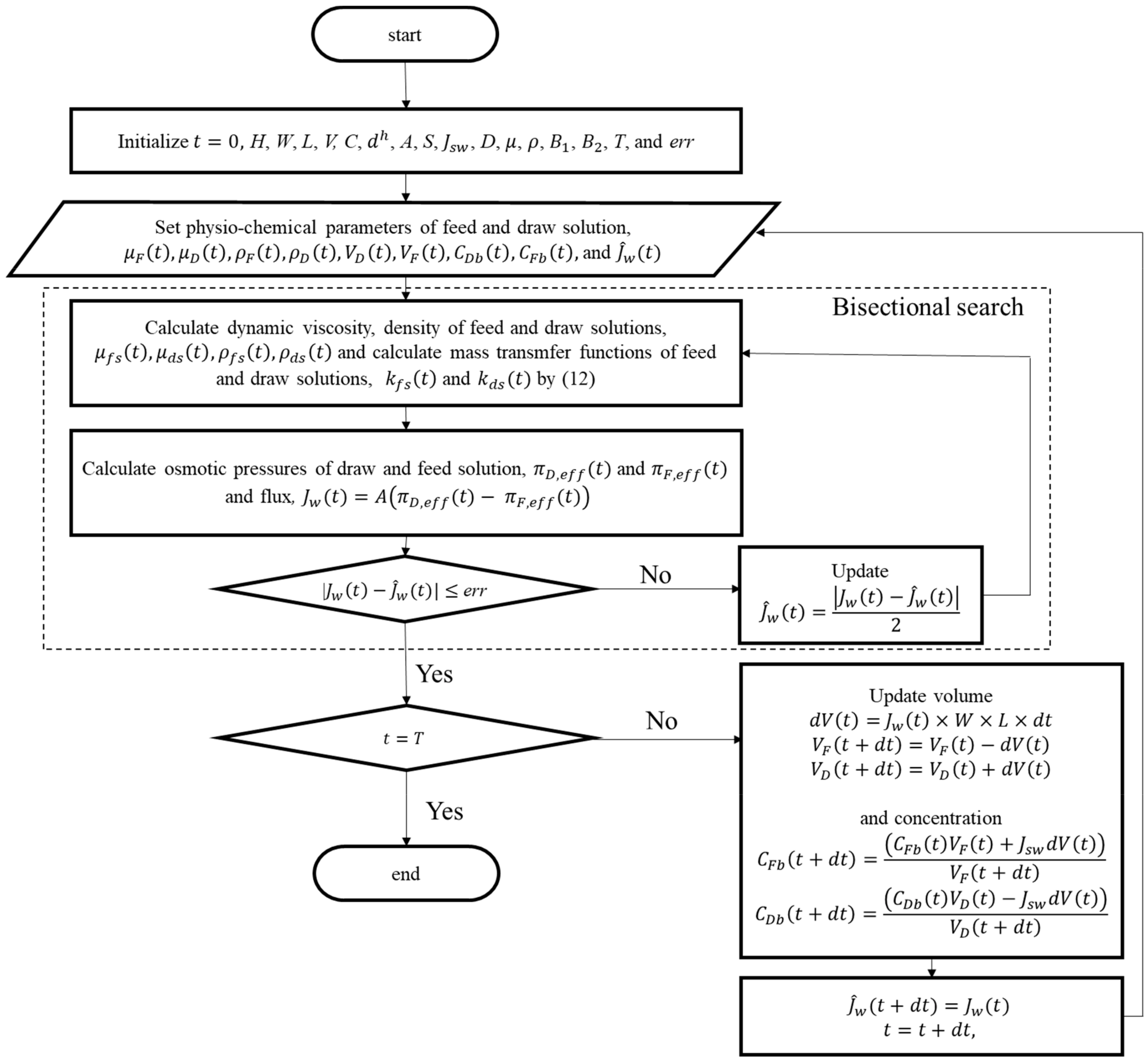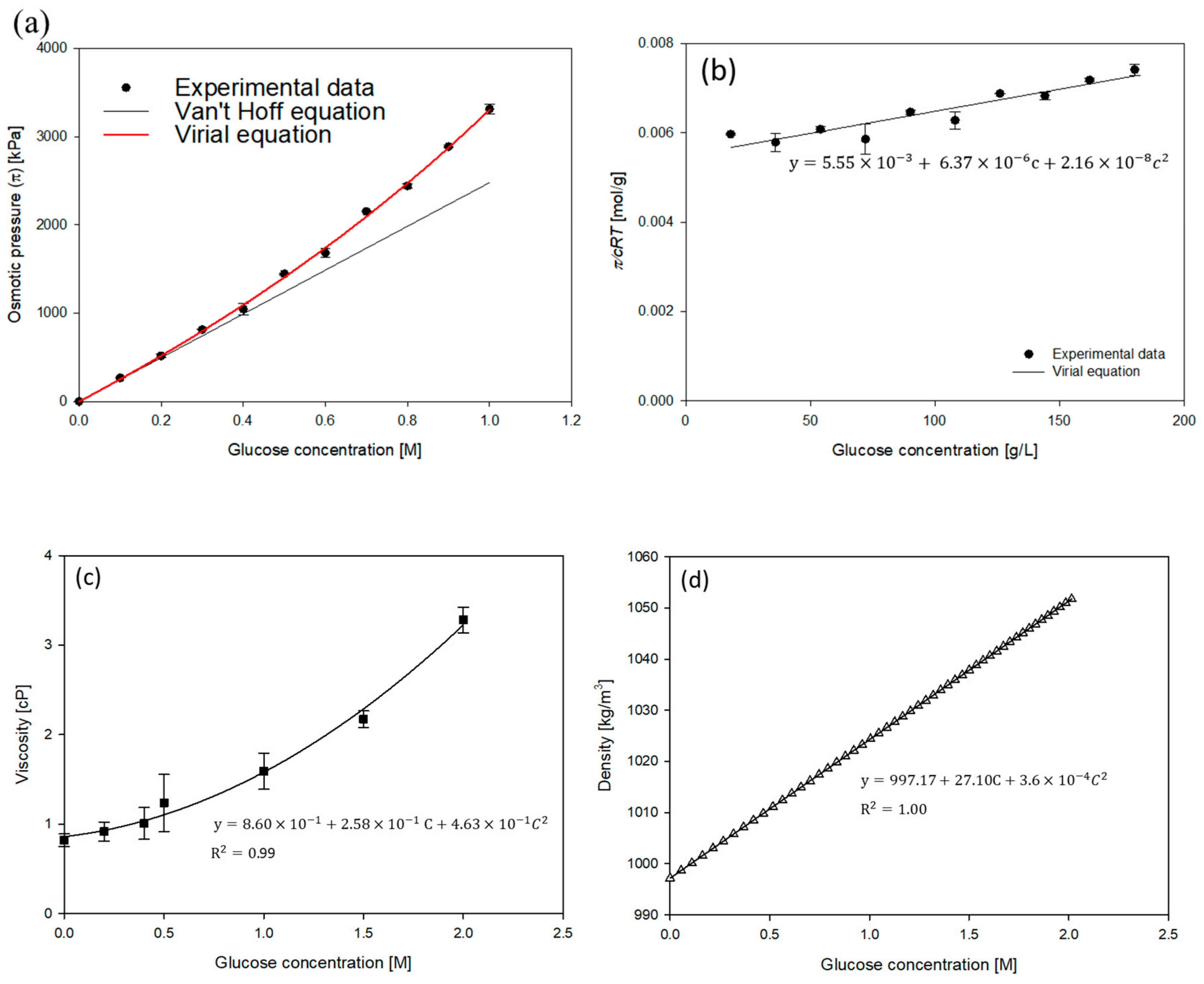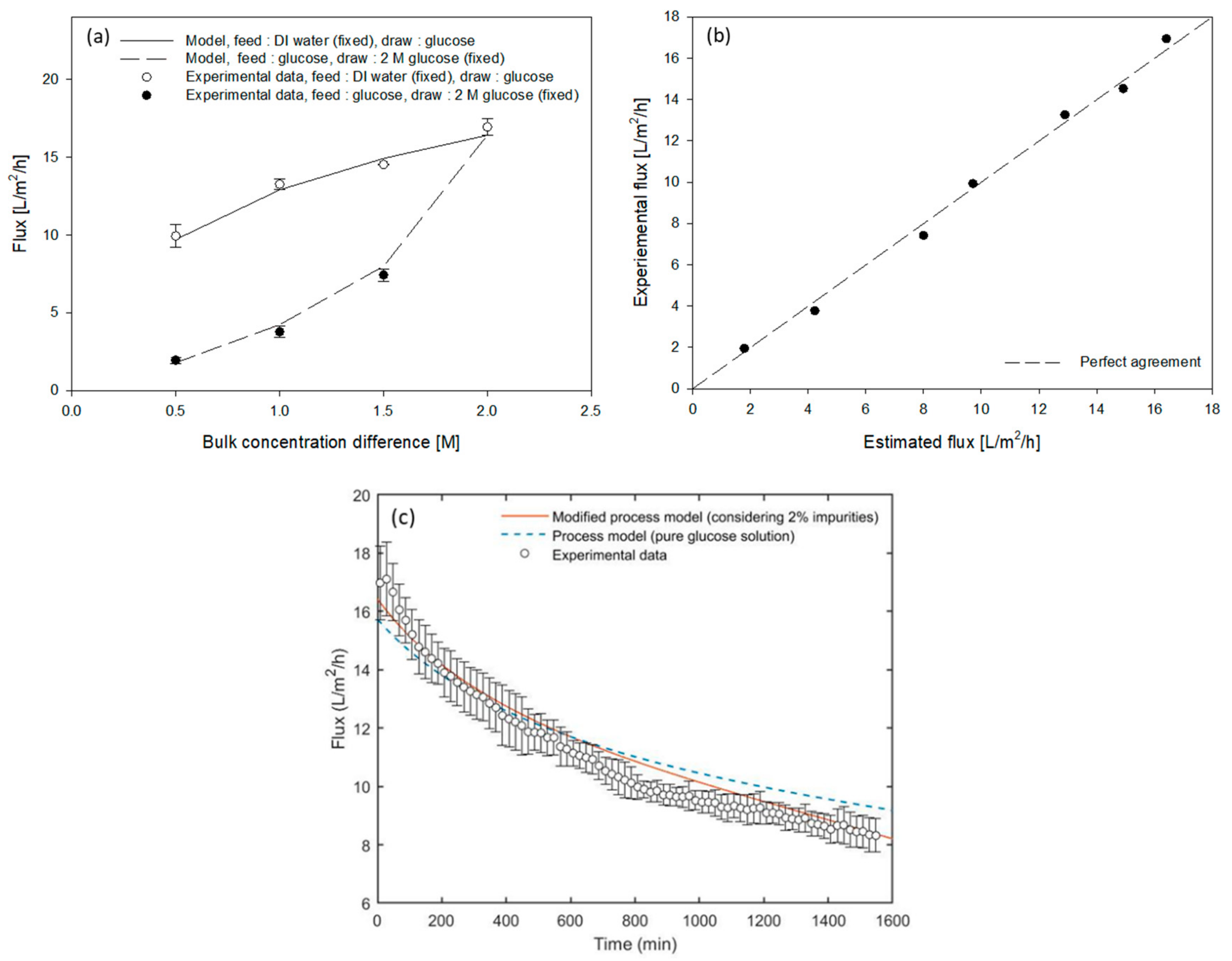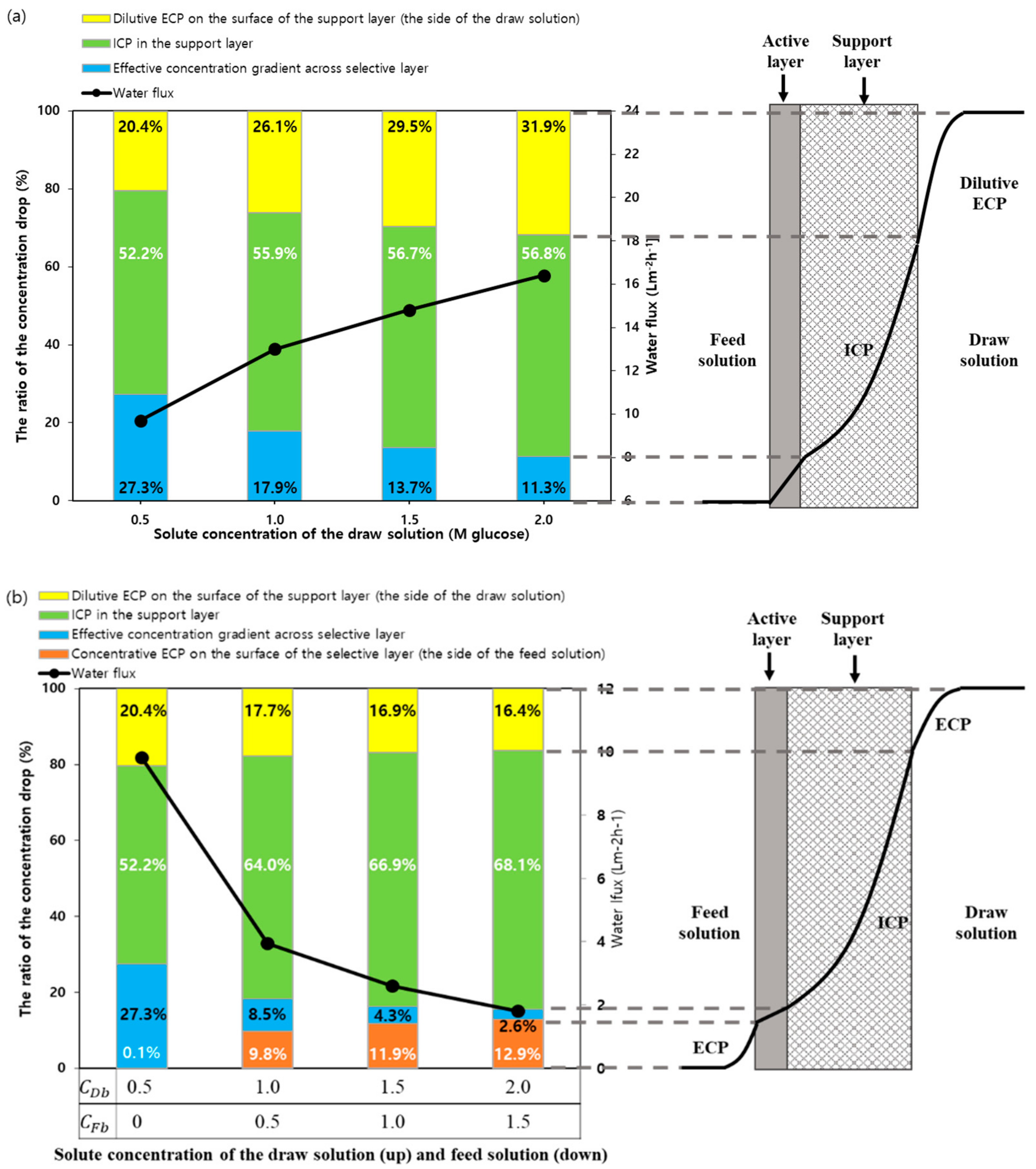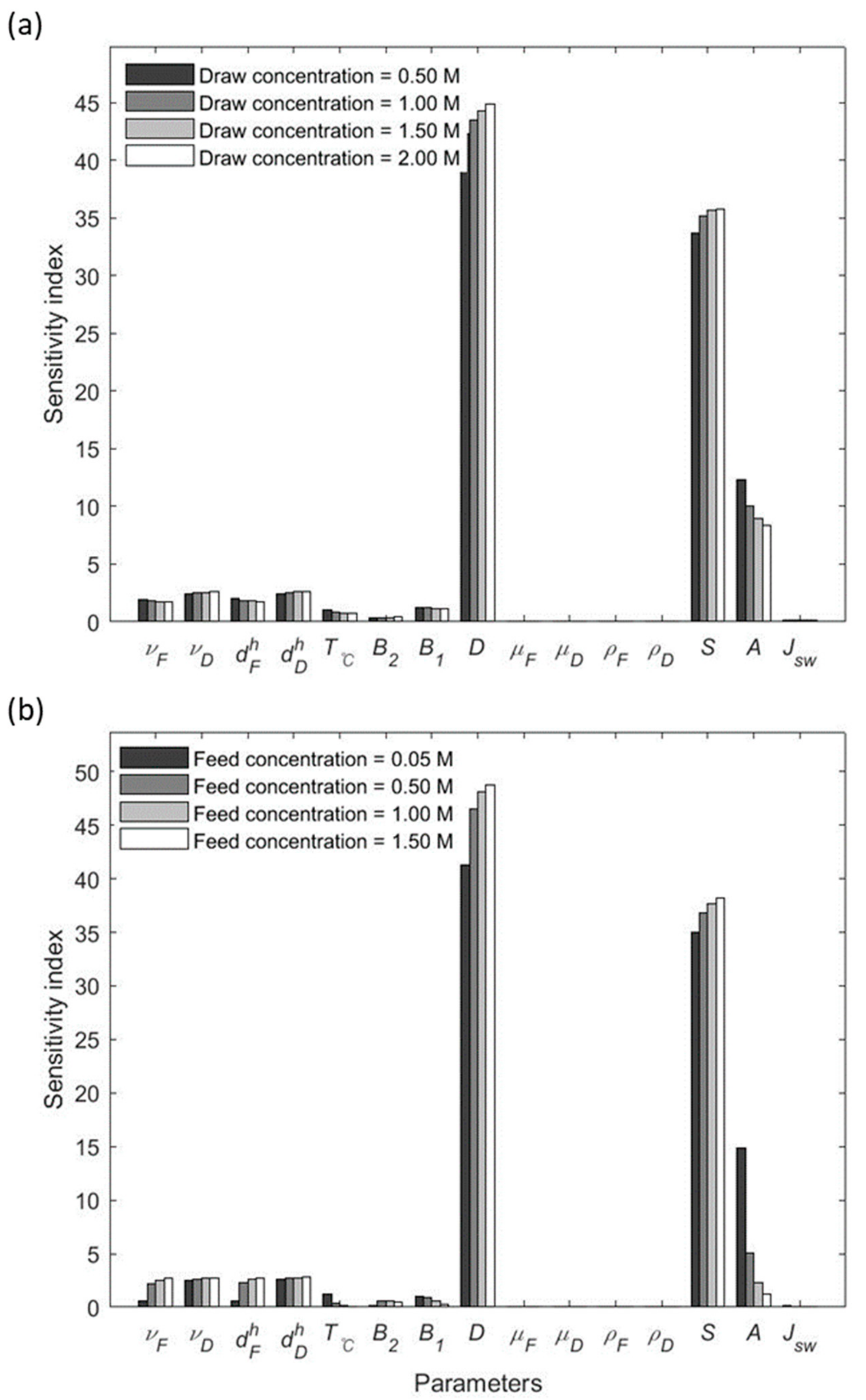1. Introduction
Water shortages have become a key issue facing humanity. According to the United Nations World Water Development Report in 2019, over 2 billion people suffer from severe water shortage, and the global demand for fresh water has been increasing by about 1% annually since the 1980s [
1]. Consequently, much effort has been made to secure water, in particular safe water, with low energy consumption. One such means is membrane-based water treatment and desalination technology, which is relatively energy-efficient and independent of the water cycle [
2].
Several types of membrane-based desalination technology, including electrodialysis, membrane distillation, reverse osmosis (RO), and forward osmosis (FO), have been developed [
3,
4]. Among these, FO-based water desalination, of which the driving force is an intrinsic osmotic pressure gradient, has a unique position because (1) it is highly resistant to membrane fouling [
5], (2) it requires much lower energy [
6] and exerts higher driving force than conventional physical separation methods if proper draw solutes are used, and (3) it does not deteriorate the physical properties of feed solution (e.g., color, taste, aroma, and nutrition) [
7,
8]. For these reasons, FO is viewed as workable especially for difficult feed water with high salinity or foulants. FO can be applied to treat hypersaline streams that are too concentrated for RO [
9]. Special cases in which there is no requirement to regenerate draw solution also have high potential, as draw solute: It is possible to use diluted fertilizer for direct fertigation [
10,
11,
12] including wastewater treatment [
13] and food concentration [
7,
8]. One such case is the use of fertilizer.
However, there are still many difficult barriers to field implementation of the FO process. Typical problems involve intrinsic, performance-reducing properties, including concentration polarization (CP) and reverse solute diffusion (RSD) [
14]. Since both sides of the membrane are in contact with two kinds of solutions, feed solution, and draw solution, CP occurs predominantly at the outer surface of the membrane, which is in contact with both solutions. When CP occurs on the exterior of the membrane, the polarization process is termed external concentration polarization (ECP). Because the polarized layer on the feed side is very concentrated, while the layer on the permeate or draw side is more diluted than the bulk solution, the overall process obstructs the mass transfer of water molecules across the selective layer [
15]. Solutions to this problem include crossflow and well-designed hydrodynamics, which are known to mitigate ECP to some degree. Another idea with good potential, and which has already been implemented in commercial FO membranes, involves an asymmetric structure of a porous support layer topped by a highly selective layer. Another critical issue is what is called internal concentration polarization (ICP), resulting from the inherent structure of the membrane: The porous support layer is in contact with the draw solution, while the solute that has diffused through pores from the draw solution to the inner part of the membrane reduces the net concentration gradient, which is, in fact, the actual driving force that moves water through the selective layer [
16]. Because ICP is inherent to the membrane, it is difficult, if not impossible, to mitigate it [
17]. The diffusion of draw solute into the feed solution, reverse solute diffusion (RSD), which occurs due to the solute concentration gradient is another tough challenge [
18]. RSD, together with cake foulants on the feed side, worsens ECP [
19]. This cake-mediated CP leads to a net concentration difference, reducing water transport across selective layer [
20]. All this is closely related to FO performance and has a negative role in industrial-scale FO processing.
To unravel the effects of key physio-chemical factors, modelling has been practiced in a way that connects model parameters or subsets of factors that influence the FO performance to the various physio-chemical phenomena. Loeb et al. [
21] suggested an FO model that considered a reverse solute flux (RSF) and Tang et al. [
22] improved Loeb’s model by including the concept of reverse solute selectivity, which is described by the ratio of RSF to the water flux. A more advanced model of the reverse flux of a draw solute was developed and validated by Phillip et al. [
14]. Suh and Lee [
23] furthered Phillip’s model by considering the ECP of both the draw and feed sides; their results were validated with previous experimental data. However, little effort has been made to date to understand the flux behavior of a practical FO system. Models focus on steady-state flux and disregard the kinetics of the development of the fouling layer. In addition, the van’t Hoff equation, while only used for ideal and dilute solutions, has been applied indiscriminately, i.e., regardless of concentration and characteristics of solute, to define the osmotic pressure of solution; what is worse, any model using the van’t Hoff equation shows large deviation compared to experimental data when dealing with high concentrations of draw solutes [
23].
In this study, a more practical and precise model was developed to realize the real-time behavior of the process with a viral equation, represented by concentrations, volumes, and water flux of the system. The model parameters were estimated to reflect the effects of high concentrations of glucose as draw solute. To validate the proposed model, FO filtration experiments were carried out with a commercialized FO membrane in batch mode using glucose as a draw solute and deionized water and glucose solution as a feed solution. For the batch operation of the FO process, the model prediction of the permeate flux profiles was found to be in line with the experimental data. To obtain insight into the dominant factors affecting permeate water flux, global sensitivity analysis using the Latin-hypercube—one-factor-at-a-time (LH—OAT) method was carried out.
2. Modeling Procedures
2.1. Water Flux in Forward Osmosis Process
The transport of water molecules through FO membranes can be represented by irreversible thermodynamics, with the membrane treated as a black box, as has been done for biological membranes [
24]. In this approach, the water flux (
) for the FO process (
Figure 1), in which hydraulic pressure differences are absent, can generally be described as follows,
where
A is the water permeability,
represents the osmotic pressure at the interface between selective layer and support layer, and
represents the osmotic pressure at the interface between selective layer and feed solution as shown in
Figure 1. This equation indicates that the water flux is linearly proportional to the effective osmotic pressure difference,
, across the FO membrane selective layer.
2.2. Osmotic Pressure of Glucose
To establish the relationship between osmotic pressure and solute concentration, the van’t Hoff (1887) equation can be applied for the osmotic pressure (
) for an ideal dilute solution [
25], that is,
where
n represents the van’t Hoff factor (n = 1 for glucose),
C is the solution molar concentration (molarity),
R = 0.0821 L·atm·mol
−1·K
−1 the ideal gas constant, and T is absolute solution temperature (K). Although the van’t Hoff equation is well fitted for dilute and ideal solutions in which ions do not affect each other, this is not applicable to the FO process, which deals with highly concentrated draw and feed solutions [
25]. In order to more precisely model the osmotic pressure of general solutions, a modification is made in the van’t Hoff equation, which is then expressed by a virial expansion to a power series [
26,
27], as follows:
In this equation, the value c represents the solution concentration (g·L
−1),
Mw is the solute molecular weight, and
B1,
B2, and
B3 are virial osmotic coefficients. It is possible to obtain these virial coefficients empirically by using Equation (3) to fit the experimental osmotic pressure data. It is generally accepted that it is sufficient to determine the coefficients up to the second coefficient (
B1 and
B2) for the purpose of reproducing the observed osmotic pressure [
28].
2.3. Concentration Polarization
Many experimental and theoretical studies have demonstrated that observed water flux values are significantly smaller than those calculated on the basis of difference in bulk concentration. The reason behind this discrepancy is the formation of ICP and ECP; both decrease the effective concentration slope across the FO membrane selective layer; as a result, the value of water flux that is observed,
is inevitably lower than expected [
29].
2.3.1. Internal Concentration Polarization
It is known that ICP in the support layer can cause severe degradation of cross-membrane water permeation in the FO process [
17]. For a porous support layer, in which draw solution is in contact with the porous support, there is a concentration gradient that is steeper than that found in bulk solution. This happens because of decreased solute diffusivity due to porosity and tortuosity. This dilutive ICP brings about a decrease in the net concentration difference across the selective layer and results in a corresponding decline in water flux [
29]. According to previous studies [
14,
23], the solute concentration at the interface between support and selective layers (
) can be described as follows:
Here,
represents the concentration of the solute on the surface of the support layer membrane and
indicates thickness of the support layer
is the reduced solute diffusivity in the porous support layer [
30]. S denotes the membrane structural parameter of the support layer, described as follows [
14],
Equation (5) pertains to the effective distance of the support layer through which a solute must pass to move to the selective layer from the boundary area of the support layer and the draw solution. In experiments using both RO and FO, the average distance of
S can be determined and has been described in the literature [
14].
2.3.2. External Concentration Polarization
ECP is of great importance in any pressure-driven desalination process, e.g., reverse osmosis [
31]. This holds true for the FO system, as the presence of ECP lowers the water movement via a reduced effective concentration gradient through the membrane. This phenomenon was reflected even in some early FO models, such as those of Phillip [
14] and Suh and Lee [
23]. In fact, because the FO membrane is in contact with two different solutions, ECP can arise on both sides of the membrane surface. To elaborate, the feed side membrane surface faces a concentrated feed solution, a phenomenon termed concentrative ECP; the permeate side membrane surface faces a diluted solution, a phenomenon termed dilutive ECP. According to previous studies [
14,
23], the solute concentrations at the membrane surface on the support layer (
) and selective layer (
) can be estimated as follows,
Here,
and
are the bulk solute concentration of draw and feed solutions, respectively.
can be described in relation to mass transfer coefficient (
k); this value has a direct relationship to the Sherwood number (
Sh), and also corresponds to the hydrodynamics of the system (
), which can be estimated in the previous studies [
14,
19,
23,
31].
2.4. Reverse Solute Flux (RSF)
can also be described as shown below [
16]:
Here,
B is the salt permeation coefficient. Substituting Equations (4) and (7) for
and
into Equation (8) can represent the effective solute flux existing between the draw solution and the feed solution, with measurable variables,
Note that Equation (9) contains the proportion of RSF to water flux
as a repetitive term, referred to as the specific RSF [
32]. Past research has demonstrated that the specific value of RSF (
) can be replaced by a constant [
14,
27,
33], meaning that more water flux leads to more draw solute moving through the membrane. Philip et al. [
14] and Suh and Lee [
23] also dealt with the selectivity of reverse flux (
), which is designated as the reverse form of the specific value of RSF; they also validated the dependency of the reverse flux selectivity (
) on the characteristics of the membrane selective layer (water (
A) and solute (
B) permeability values in the
Appendix A), as follows:
This result provides insight into the selectivity of the reverse flux, showing that it is independent of the concentration of the bulk draw solute, the crossflow velocity, and structural parameter
S, and can be handled as a constant coefficient determined in experiments, provided that these experiments are conducted with the same membrane, the same draw solutes, and identical temperature. Thus, the specific RSF (
) can be described as a constant model parameter:
Finally, the equation of reverse solute flux and forward water flux for the FO system can be rearranged as follows:
It should be noted that for Equation (12), and are easily measurable independent variables, and A, , , and are model parameters. Before simulating FO performance, these model parameters should be determined by experiments. Then, only one unknown dependent variable of the equation remains, namely . However, Equation (12) is implicit forms with regard to , and cannot be solved explicitly. Consequently, recursive numerical procedures must be used to solve these implicit flux equations.
2.5. Mass Balance for Dynamic Modeling (Multistage Operation)
When FO is carried out as a batch operation in such a way that there is an increase of the draw volume and a decrease of the feed volume, such that water molecules continually traverse the FO membrane from feed solution to draw solution, as shown in
Figure 2, the time profile for the entire system changes analogously depending on the actual time and can, if the observation time interval (or sampling time interval) of each stage is sufficiently short but not too short (because mass transfer should be reached in quasi-steady state), be expressed as a discrete multistage process, as shown in
Figure 3. Considering module length and average crossflow velocity of solution, we set the observation time interval or sampling time interval to 0.5 s because the water molecule takes 0.5 s after entering to exit the FO module. It is assumed that the FO system reaches quasi-steady state at each stage during this sampling time interval. The mass balance of solutes for feed and draw solutions at the
j-th stage (or at the
j-th sampling in
Figure 3) of the FO unit for batch operation can be represented by
and
Here, C represents the concentration of individual components, V is the volume, Js is the reverse solute flux, Am is the effective area of the membrane, ts is the time interval, the subscript Fb is the bulk feed solution, the subscript Db is the bulk draw solution, the subscript D is the draw solution, the subscript F is the feed solution, and the superscript j is the sampling index.
The total volume of the system, including the feed and draw solutions, remains constant because the volume loss of the feed solution via transverse-FO-membrane water flux permeation is included in the draw solution volume. This relationship is presented below.
and
Here, Jw is forward water flux.
2.6. Numerical Simulations
Using the proposed model for the FO process, all iterative calculations for the water flux profile were conducted with MATLAB software under conditions identical to those of the batch operation experiments described above.
Figure 4 provides a flow chart of the proposed multistage FO modeling procedure. First, the timer was reset, and invariant variables were initialized. Then, the initial physio-chemical parameters of the feed and draw solutions of the
j-th stage are set. In this step, the initial estimate of water flux
was also properly set. With the given physio-chemical variables and
, calculations of the dynamic viscosity, density, and mass transfer functions of the feed solution and the draw solution were performed, yielding feed and draw solution osmotic pressure values. From the obtained osmotic pressures, the water flux
was obtained. This calculation was repeated with the updated
using the mean value of
and
until the error tolerance condition,
was satisfied. The implicit equation in the proposed model was solved using the bisectional method: The embedded MATLAB ‘fzero’ function [
23]. If this
j-stage is not reached by the final stage, as we had hoped, i.e.,
, the volume and feed and draw solution concentrations were revised using the value of
determined for the next stage.
2.7. Sensitivity Analysis Using Latin-Hypercube—One-Factor-at-a-Time (LH–OAT) Method
Sensitivity analyses of model parameters and operating conditions were executed with the Latin-hypercube—one-factor-at-a-time (LH–OAT) method [
34], combing Latin-hypercube (LH) sampling [
35] and one-factor-at-a-time methods (OAT) [
36]. In the LH method, proposed by McKay for use instead of the Monte Carlo method, the parameter space is divided into N intervals with the same probability, and only one variable is randomly extracted from each interval and analyzed by multivariate linear regression. Though this method is advantageous compared to other global sensitivity analyses in that its computational calculation is efficient [
34,
37], it has limitations in that a linear regression analysis is assumed and the sensitivity to one specific individual variable cannot be identified [
34]. To analyze the sensitivity in the OAT method, on the other hand, only one variable in the parameter space is sequentially selected for a small change of the selected parameter, while other parameters are fixed as constant [
36,
38]. In general, the OAT method has been widely used as an efficient method of local sensitivity analysis. One downside is that it does not give any information on global sensitivity for the whole parameter space. By combining LH sampling and OAT design, therefore, the merits of both methods can be exploited [
39]. The process begins with sampling N LH points randomly for N intervals as initial points; this is followed by OAT analysis, in which each of the P parameters is changed [
34]. For sensitivity analysis, parameters affecting FO performance were investigated by changing figures with standard deviations of 10%.
5. Conclusions
In this paper, a numerical dynamic model was established, capable of predicting results for a process of forward osmosis (FO). After a parameter estimation process, the model was found to be capable of describing significant physio-chemical phenomena during the FO process, such as the internal (ICP) and external concentration polarization (ECP), as well as diffusion of the reverse draw solute. The proposed model was verified through comparisons with experimental data. The results of our simulation agree well with the empirical data. Furthermore, the influences of the ICP and ECP on the FO system water flux were investigated with different solute concentrations. The simulation results indicate that the influences of the ICP, ECP, and reverse draw solute flux must be taken into account for FO systems. It was also observed that the concentrative ECP on the selective layer surface does not need to be taken into account when deionized water is used as a feed solution. However, the concentrative ECP is not negligible if the salinity of the feed solution exceeds a certain point. Similarly, the high salinity of a draw solution can affect the dilutive ECP on the support layer surface, because the changes in the ECP can have an effect on the support layer dilutive ICP. Furthermore, with the verified model, a global sensitivity analysis was used to consider the effects of certain model parameters on the FO performance. The simulation results confirmed solute diffusivity is the most influential parameter for water flux; the reason is that the solute diffusivity directly affects both ECP and ICP.
